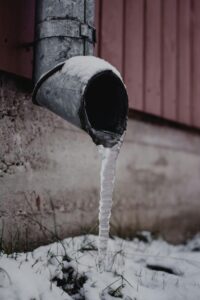When temperatures drop below freezing in Reno, your home’s plumbing faces one of its biggest winter threats — frozen pipes. Not only can frozen water pipes stop your water flow, but they can also lead to burst pipes, flooding, and expensive repairs.
At Rooter Man Plumbing, we want to help you understand what causes frozen pipes, how professionals safely handle them, and the best steps for protecting pipes from freezing before winter strikes.
What Causes Frozen Pipes?
Frozen pipes happen when the water inside your plumbing drops below 32°F and begins to solidify. Because water expands as it freezes, this can create intense pressure inside the pipe, causing cracks or even a full rupture.
Pipes most at risk include:
-
Uninsulated lines in attics, crawl spaces, garages, and exterior walls
-
Outdoor hose bibs and sprinkler lines
-
Pipes located behind poorly sealed windows or doors
How to Thaw Frozen Pipes? Why You Shouldn’t DIY
If your faucets suddenly stop working or water only trickles out, you’re likely dealing with frozen water pipes. While it may be tempting to try thawing them yourself, doing so can cause serious damage if not handled correctly.
Applying direct heat, using open flames, or heating pipes too quickly can lead to:
-
Cracked or burst pipes
-
Water damage to walls, floors, and insulation
-
Electrical hazards or house fires
Because frozen pipes can rupture without warning, it’s safest to leave the thawing process to professionals. At Rooter Man Plumbing, our licensed technicians use specialized tools and safe heating methods to locate and thaw frozen sections without damaging your plumbing. We also inspect your system to identify weak spots that could lead to future freeze-ups or leaks.
If you suspect your pipes are frozen, turn off your main water supply and call Rooter Man Plumbing right away. Acting quickly can prevent a burst and save you from major water damage and costly repairs.

What to Do If a Pipe Bursts
Sometimes frozen pipes thaw too late — and the pressure causes them to burst. If that happens:
1. Shut off your main water supply immediately.
2. Turn off electricity near the affected area for safety.
3. Call Rooter Man Plumbing right away for emergency burst pipe repair in Reno.
We’ll locate the damaged section, replace the broken pipe, and inspect your plumbing to ensure there are no other weak points that could lead to future problems.
How to Prevent Frozen Pipes This Winter
Prevention is the best protection. Here’s how you can start protecting pipes from freezing before cold weather sets in:
1. Insulate Exposed Pipes
Wrap pipes in foam insulation sleeves or heat tape, especially those in basements, crawl spaces, and attics.
2. Seal Gaps and Cracks
Cold air sneaks in through small openings around windows, doors, and walls. Seal these areas with caulk or weatherstripping.
3. Let Faucets Drip
When temperatures drop below freezing, allow vulnerable faucets to drip slightly. A slow, steady flow keeps water moving — reducing the risk of frozen pipes.
4. Keep the Heat On
Maintain a consistent indoor temperature (at least 55°F), even when you’re away from home.
5. Open Cabinet Doors
In kitchens and bathrooms, open cabinet doors under sinks to allow warm air to circulate around the plumbing.
6. Replace Aging Pipes
Older plumbing is more prone to cracking and bursting. Replacing outdated pipes now can prevent major issues later — and improve your home’s overall water pressure and quality.
Call Rooter Man Plumbing for Frozen Pipe and Burst Pipe Repair in Reno
If you suspect frozen pipes or have already experienced a burst pipe, don’t wait. The longer you delay, the higher the risk of costly water damage.
At Rooter Man Plumbing, we provide fast, professional service throughout the Reno and Carson City area. Our team can locate frozen sections, thaw them safely, and perform reliable burst pipe repair to get your water flowing again.
Protect your home this winter — call Rooter Man Plumbing today for help with frozen water pipes and all your plumbing needs.
Frequently Asked Questions About Frozen Pipes
❄️ How can I tell if my pipes are frozen?
If your faucets produce little or no water, or if you notice frost on exposed pipes, it’s a strong indicator that your plumbing has frozen.
❄️ What should I do if I suspect frozen pipes?
Turn off your home’s main water supply and call a professional plumber immediately. Trying to thaw pipes on your own can cause them to burst.
❄️ How long does it take for pipes to freeze?
Pipes can freeze within hours when temperatures drop below 20°F — especially if they’re uninsulated or exposed to drafts.
❄️ Can frozen pipes burst after thawing?
Yes. As the ice melts, built-up pressure can cause cracks to split open and water to leak. That’s why professional thawing is essential.

